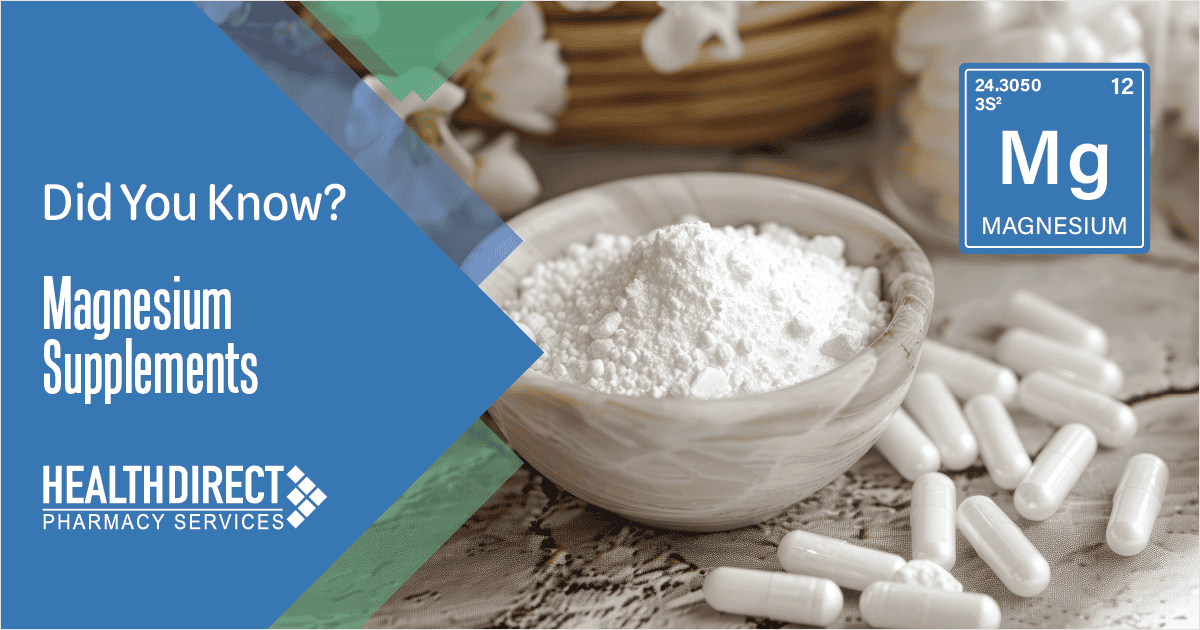Magnesium Status and Aging
Magnesium, an abundant mineral in the body, is naturally present in many foods, available as a dietary supplement, and present in some medicines (such as antacids and laxatives).
Magnesium is a cofactor in more than 300 enzyme systems that regulate diverse biochemical reactions in the body, including protein synthesis, muscle and nerve function, blood glucose control, and blood pressure regulation.
Magnesium’s crucial role in muscle function, nerve and cognitive health, blood pressure regulation, and bone health are particularly important for older adults. As we age however, magnesium absorption and retention can decrease, leading to deficiency and health consequences.
Older people are more susceptible to magnesium deficiency due to these factors like decreased absorption from food, increased medication use (diuretics can deplete magnesium), and potential dietary restrictions.
A review of dietary intake and consideration for supplementation may be indicated if magnesium deficiency is suspected and confirmed.
Dietary Sources and Recommended Daily Allowance (RDA)
The recommended daily intake of elemental magnesium varies based on age, gender, and specific health conditions. For older adults (>50 years), the National Institute of Health recommends 320 mg of magnesium for females and 420 mg for males each day. Individual requirements, of course, may vary.
Magnesium is widely distributed in plant and animal foods and in beverages. Green leafy vegetables, such as spinach, legumes, nuts, seeds, and whole grains, are good sources. In general, foods containing dietary fiber provide magnesium. Tap, mineral, and bottled waters can also be sources of magnesium, but the amount of magnesium in water varies by source and brand (ranging from 1 mg/L to more than 120 mg/L). Approximately 30% to 40% of the dietary magnesium consumed is typically absorbed by the body.
Magnesium Supplementation
Healthy individuals with adequate dietary intake rarely develop magnesium deficiency because the kidneys normally can regulate magnesium levels. Still, magnesium supplements are increasingly common and marketed for a wide array of health benefits, including blood pressure control, sleep quality, mood and anxiety disorders, cardiovascular risk, muscle and nerve support, blood glucose regulation and energy support.
Magnesium supplementation may support these functions for those found to be deficient and are generally considered safe, however most medical professionals do not recommend additional magnesium intake in absence of deficiency.
Magnesium supplements can cause GI discomfort (diarrhea, nausea, dyspepsia) and may lead to adverse effects and toxicity for those with kidney disease.
Magnesium supplements come in a variety of forms, some of which our bodies can absorb more easily than others. A summary of available magnesium salts and their common uses is provided in the table below:
| Magnesium Salt | % Elemental Magnesium | Common Uses | Comments |
|---|---|---|---|
| Magnesium aspartate | 7% | dietary supplement hypomagnesemia | good bioavailability |
| Magnesium chloride (e.g., SlowMag) | 12% | dietary supplement hypomagnesemia (preferred) | good bioavailability well-tolerated |
| Magnesium citrate | 16% | laxative (constipation, bowel prep) dietary supplement | good bioavailability |
| Magnesium gluconate | 5.9% | dietary supplement hypomagnesemia (preferred) | good bioavailability lower risk of diarrhea |
| Magnesium glycinate | 14% | dietary supplement hypomagnesemia | good bioavailability |
| Magnesium hydroxide (e.g., Milk of Magnesia) | 41.8% | antacid laxative hypomagnesemia | diarrhea (problematic when used as an antacid) |
| Magnesium lactate (e.g., Mag-Tab SR) | 12% | hypomagnesemia (preferred) | good bioavailability |
| Magnesium oxide (e.g., MagOx) | 60.5% | antacid dietary supplement hypomagnesemia | poor bioavailability (4%) diarrhea (higher risk) |
| Magnesium sulfate (Epsom Salt) | 10% | laxative | poor bioavailability (4%) |
*adapted from Clinical Resource, FAQ: Magnesium Supplements. Pharmacist’s Letter/Prescriber’s Letter. July 2022. [380705]
Magnesium Deficiency
Early signs of magnesium deficiency include loss of appetite, nausea, vomiting, fatigue, and weakness. As magnesium deficiency worsens, numbness, tingling, muscle contractions and cramps, seizures, personality changes, abnormal heart rhythms, and coronary spasms can occur.
Severe magnesium deficiency can result in hypocalcemia or hypokalemia (low serum calcium or potassium levels, respectively) because mineral homeostasis is disrupted.
Clinical settings in which hypomagnesemia should be assessed include the following:
- Chronic diarrhea or malabsorption (e.g. hx of bypass surgery)
- Alcohol use disorder
- Treatment with medications that can cause hypomagnesemia
- Unexplained hypokalemia or hypocalcemia
- Neuromuscular disturbances, such as tremor, tetany, seizures, weakness, apathy, delirium, or coma
- Ventricular arrhythmias
Patients suspected of hypomagnesemia should be evaluated by history and laboratory testing to identify the underlying cause and determine if low magnesium is contributing to current symptomatic presentation.
The normal range for blood magnesium level is typically 1.7 to 2.2 mg/dL (0.85 to 1.10 mmol/L), however the range may vary slightly depending on the reporting laboratory, patient’s age and gender. Treatment of hypomagnesemia should be focused on addressing the underlying cause.
Some patients will require magnesium supplementation depending upon the presence of symptoms and their serum magnesium concentration. The treatment plan should include periodic reassessment of continued need for supplementation and monitoring for adverse GI effects.
Medications Linked to Magnesium Depletion
The following medications can contribute to magnesium depletion either by gastrointestinal malabsorption or urinary loss. The medical provider team, including pharmacists, should consider adding routine serum magnesium level monitoring for these individuals to screen for and prevent complications of hypomagnesemia.
- Proton Pump Inhibitors (PPIs)
- Antibiotics (aminoglycoside, amphotericin, pentamidine)
- Digoxin
- Calcineurin inhibitors (cyclosporine, tacrolimus)
- Platinum agents (most commonly with cisplatin, less commonly with carboplatin and oxaliplatin)
- Antibodies targeting epidermal growth factor (EGF) receptor (cetuximab, panitumumab)
References:
- NIH – Office of Dietary Supplements. Magnesium Fact Sheet for HCP. Jun 2022. Available from: https://ods.od.nih.gov/factsheets/Magnesium-HealthProfessional/
- Clinical Resource, FAQ: Magnesium Supplements. Pharmacist’s Letter/Prescriber’s Letter. July 2022. [380705]
- UpToDate. Hypomagnesemia: Evaluation and Treatment. Updated Aug 2024. Subscription required to view




